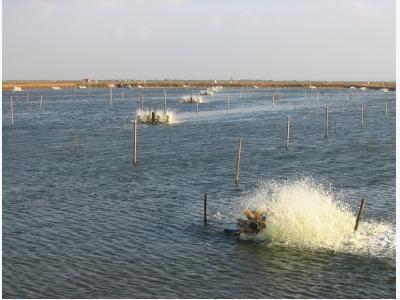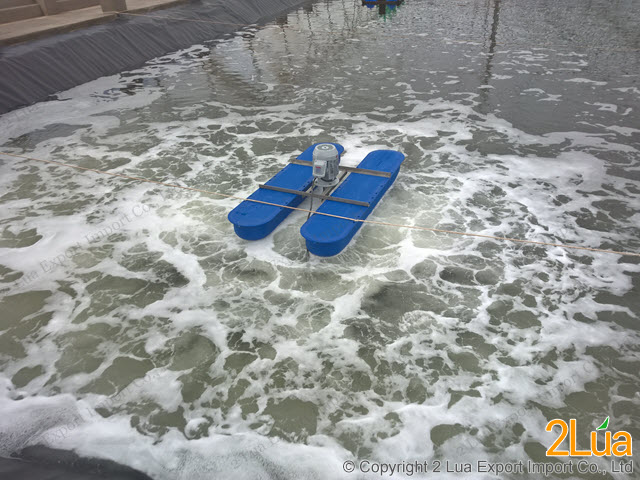Proper water circulation in aquaculture ponds, Part 2

Aeration a critical consideration for effective management, successful production
The stratification of a pond limits the supply and availability of oxygen to the upper strata of the water column. At night, this limited oxygen reserve is quickly consumed by the respiration of plankton, fish and/or shrimp, a variety of microorganisms, and the oxidation of reduced compounds in the water and pond bottom soil. To avoid oxygen deficits, fish farmers often provide ponds with nighttime aeration. In shrimp ponds, farmers also turn on the aerators for some hours during the day to increase oxygen levels and overall quality of bottom water and pond soil, as shrimp exploit natural food organisms and feed on sinking pellets in this zone
Water circulation is an effective strategy to mix high-oxygen surface waters with low-oxygen (anaerobic) bottom waters (Figure 4). On sunny days, surface waters are invariably supersaturated with oxygen from microalgae photosynthesis. Photosynthesis, therefore, is the fastest, most efficient and inexpensive way to incorporate oxygen into pond water. In aquaculture ponds, on photosynthetic peak hours (from about 11 am to 3 pm), surface oxygen concentration increases over 2 mg O2/L/hr. (or 2 g O2/m3/hr.). Photosynthesis is capable of supersaturating pond surface waters with oxygen much more efficiently than the most efficient ceramic microbubble diffusing plate used to oxygenate hauling fish tanks.
If we consider a 1-ha pond (10,000 m2), and a surface water layer of 0.6 m, the incorporation of 2 g of oxygen/m3/hr. through photosynthesis equals to 12 kg of oxygen/hr. added to pond water. In comparison, paddlewheel aerators and vertical pumps effectively incorporate about 1 kg O2/hp/hr. Therefore, to incorporate the same amount of oxygen added by photosynthesis, theoretically, it would be necessary to apply 12 hp/hr. of mechanical aeration. In fact, much more aeration power is needed, since mechanical aerators can only incorporate oxygen to water up to the DO saturation point (about 7.8 mg O2/ L at 28°C at sea level in freshwater, and 6.4 in sea water at a salinity of 36 ppt). And the oxygen incorporation through mechanical aeration occurs at a very high use of and cost of energy, as the closer to the saturation the DO gets, the less efficient is the transfer of atmospheric oxygen into water through mechanical aeration.
 |
| Fig.4: Oxygen profile from surface to bottom in a 0.84 ha hillside fish pond before and after two hours of water circulation using two 2-hp paddlewheel aerators (4.76 hp/ha) from 12:00 to 14:00 (author’s field observation). After the circulation, DO levels at the surface diminished because of oxygen diffusion to the air, as paddlewheels disturbed the oxygen supersaturated surface water. However, oxygen concentration increased tremendously below 1 m of depth. The gain of oxygen in the deepest strata (green area) is nearly 7 times greater than the loss of oxygen in surface waters (red area). Therefore, water circulation increased the overall reserve of oxygen in the pond. Image by Fernando Kubitza. |
Szyper and Lin (1990), in a study on water circulation in 1.4 to 1.6 m deep tilapia ponds with the same stocking and feeding management, observed that ponds receiving two hours of water circulation during the photosynthesis peak hours (noon to 1 pm and 3 to 4 pm) had early morning (6 am) oxygen levels of about 3 mg/L compared to less than 0.5mg/L in ponds without circulation. Therefore, water circulation is an effective mean to increase the overall oxygen reserves for nighttime respiration of pond communities, until photosynthetic activity can restore the oxygen levels the next day. In this way, the amount of supplemental nighttime aeration applied to ponds can be significantly reduced.
How to affect water circulation?
Surface water can be pushed down (using paddlewheel, propeller-aspirator pumps or especially designed water circulators, among other devices) or bottom water can be lifted up (using air lift devices, vertical “fountains” type of aerators, or other means) to promote water circulation (Fig. 5). In order to be more effective disrupting water column stratification, incorporating oxygen into bottom waters and increasing overall oxygen reserves in a pond, water circulation should be carried out during photosynthesis peak hours, when surface water is supersaturated with oxygen.
 |
| Fig.5: Schematic representation of some devices used to promote water circulation in ponds. Some will push surface water down (paddlewheel aerators and propeller aspirators), while others will bring bottom water up (vertical pumps aerators or “fountains” fitted with 150-200 mm pipes, submerged pumps and airlift devices). Image by Fernando Kubitza. |
| Fig.6: Vertical pumps (fountain-like aerators) can be adapted with an extended 200 mm PVC pipe. The length of pipe can be adjusted according to pond depth. The extended pipe allows the circulation/movement of bottom water up, and the gradual displacement of surface water down. By doing this on a daily basis, during the time of peak photosynthesis, aquafarmers can minimize the pond stratification gradient and enrich bottom waters with oxygen. Photos by 2LUA. |
 |
| Fig.7: Double-side mounted propeller-aspirators (2 hp each propeller) that is being used to promote the mixing of pond water. Propellers push surface water down without too much surface disturbance, causing minor losses of oxygen from DO-supersaturated surface water. Photos by 2LUA. |
Benefits of water circulation
As discussed earlier, regular water circulation disrupts chemical and physical pond water stratification, makes the pond environment more homogeneous and stable, and lessens the risk of fish kills due to a sudden pond turnover. Water circulation increases oxygen storage in a pond, reducing the hours and costs of nighttime supplemental aeration. The productivity of microalgae (phytoplankton) and, thus, availability of natural food (microalgae, zooplankton and benthic organisms) is increased with water circulation. Microalgae are kept in constant movement and are supplied with nutrients recycled from organic wastes decomposed on the pond bottom. Water circulation also seems to favor beneficial microalgae, such as green algae, reducing the dominance of undesirable cyanobacteria (blue green algae) often associated with off-flavor issues in the cultured animals and with some episodes of toxicity to fish. Green algae have also been shown beneficial to reduce Vibrio infections in shrimp. As the quality of bottom water and pond soils improves through circulation, benthic organism become more available to fish and shrimp. In a well-mixed pond, fish and shrimp can better exploit all pond dimensions and have more options of natural food. As natural food serves as a source of nutrients and health-promoting factors, and pond water quality is improved, farmers will experience better growth, feed conversion ratio and survival of their cultured fish and shrimp.
Final remarks
In general, aquaculturists implicitly understand that water circulation is good for fish and shrimp. However, not all of them use water circulation as a regular management practice. My personal belief and significant field experience is that through water circulation farmers can significantly improve the quality of a pond environment, thus the production performance (growth and feed conversion), health, survival, feeding rates and, consequently, the harvest yield of cultured fish and shrimp. And I hope more farmers experiment water circulation, applying the fundamentals presented in this article. Though it is important to stress that most of the observations on water circulation are rather empirical yet, and few controlled studies have truly assessed such benefits.
| Turning on paddlewheel aerators during the peak hours of photosynthesis causes loss of oxygen from DO-supersaturated surface waters. However, paddlewheels are effective for mixing pond water and promoting the increase of oxygen in bottom waters. Photos by 2LUA. |
More comprehensive investigations on water circulation should address: a) the most efficient devices for water circulation in ponds; b) water circulation protocols and management; c) how much increase in daily feeding rate (and, thus, pond production yield) can be achieved by applying routine water circulation; d) how many hours and money spent on supplemental aeration can be spared by applying regular water circulation in ponds.
Có thể bạn quan tâm
Phần mềm

Phối trộn thức ăn chăn nuôi

Pha dung dịch thủy canh

Định mức cho tôm ăn

Phối trộn phân bón NPK

Xác định tỷ lệ tôm sống

Chuyển đổi đơn vị phân bón

Xác định công suất sục khí

Chuyển đổi đơn vị tôm

Tính diện tích nhà kính

Tính thể tích ao hồ



 Proper water circulation in aquaculture ponds critical
Proper water circulation in aquaculture ponds critical  Brazil study results encouraging for injector
Brazil study results encouraging for injector